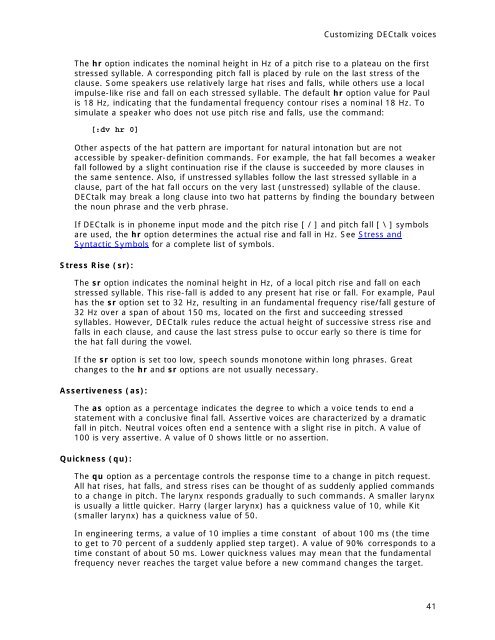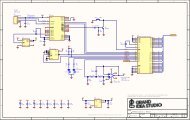Fonix proudly introduces DECtalk version 5.01-E1, the world's most ...
Fonix proudly introduces DECtalk version 5.01-E1, the world's most ...
Fonix proudly introduces DECtalk version 5.01-E1, the world's most ...
You also want an ePaper? Increase the reach of your titles
YUMPU automatically turns print PDFs into web optimized ePapers that Google loves.
Customizing <strong>DECtalk</strong> voices<br />
The hr option indicates <strong>the</strong> nominal height in Hz of a pitch rise to a plateau on <strong>the</strong> first<br />
stressed syllable. A corresponding pitch fall is placed by rule on <strong>the</strong> last stress of <strong>the</strong><br />
clause. Some speakers use relatively large hat rises and falls, while o<strong>the</strong>rs use a local<br />
impulse-like rise and fall on each stressed syllable. The default hr option value for Paul<br />
is 18 Hz, indicating that <strong>the</strong> fundamental frequency contour rises a nominal 18 Hz. To<br />
simulate a speaker who does not use pitch rise and falls, use <strong>the</strong> command:<br />
[:dv hr 0]<br />
O<strong>the</strong>r aspects of <strong>the</strong> hat pattern are important for natural intonation but are not<br />
accessible by speaker-definition commands. For example, <strong>the</strong> hat fall becomes a weaker<br />
fall followed by a slight continuation rise if <strong>the</strong> clause is succeeded by more clauses in<br />
<strong>the</strong> same sentence. Also, if unstressed syllables follow <strong>the</strong> last stressed syllable in a<br />
clause, part of <strong>the</strong> hat fall occurs on <strong>the</strong> very last (unstressed) syllable of <strong>the</strong> clause.<br />
<strong>DECtalk</strong> may break a long clause into two hat patterns by finding <strong>the</strong> boundary between<br />
<strong>the</strong> noun phrase and <strong>the</strong> verb phrase.<br />
If <strong>DECtalk</strong> is in phoneme input mode and <strong>the</strong> pitch rise [ / ] and pitch fall [ \ ] symbols<br />
are used, <strong>the</strong> hr option determines <strong>the</strong> actual rise and fall in Hz. See Stress and<br />
Syntactic Symbols for a complete list of symbols.<br />
Stress Rise (sr):<br />
The sr option indicates <strong>the</strong> nominal height in Hz, of a local pitch rise and fall on each<br />
stressed syllable. This rise-fall is added to any present hat rise or fall. For example, Paul<br />
has <strong>the</strong> sr option set to 32 Hz, resulting in an fundamental frequency rise/fall gesture of<br />
32 Hz over a span of about 150 ms, located on <strong>the</strong> first and succeeding stressed<br />
syllables. However, <strong>DECtalk</strong> rules reduce <strong>the</strong> actual height of successive stress rise and<br />
falls in each clause, and cause <strong>the</strong> last stress pulse to occur early so <strong>the</strong>re is time for<br />
<strong>the</strong> hat fall during <strong>the</strong> vowel.<br />
If <strong>the</strong> sr option is set too low, speech sounds monotone within long phrases. Great<br />
changes to <strong>the</strong> hr and sr options are not usually necessary.<br />
Assertiveness (as):<br />
The as option as a percentage indicates <strong>the</strong> degree to which a voice tends to end a<br />
statement with a conclusive final fall. Assertive voices are characterized by a dramatic<br />
fall in pitch. Neutral voices often end a sentence with a slight rise in pitch. A value of<br />
100 is very assertive. A value of 0 shows little or no assertion.<br />
Quickness (qu):<br />
The qu option as a percentage controls <strong>the</strong> response time to a change in pitch request.<br />
All hat rises, hat falls, and stress rises can be thought of as suddenly applied commands<br />
to a change in pitch. The larynx responds gradually to such commands. A smaller larynx<br />
is usually a little quicker. Harry (larger larynx) has a quickness value of 10, while Kit<br />
(smaller larynx) has a quickness value of 50.<br />
In engineering terms, a value of 10 implies a time constant of about 100 ms (<strong>the</strong> time<br />
to get to 70 percent of a suddenly applied step target). A value of 90% corresponds to a<br />
time constant of about 50 ms. Lower quickness values may mean that <strong>the</strong> fundamental<br />
frequency never reaches <strong>the</strong> target value before a new command changes <strong>the</strong> target.<br />
41








